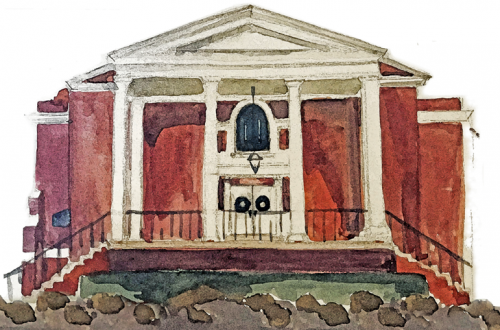 I have to say that I was agog when I saw that the nation’s paper of record—The New York Times, the old gray lady herself!—contained a feature-length story about my hometown of DeRidder, Louisiana. I would never have imagined such a thing to be possible, but there it was. My hometown is a dot on the map. It’s a place that means the world to me. But like many other small towns across the South, it’s just not the kind of place that has much of interest for coastal elites. We have local celebrities, but very few national ones. The big events in DeRidder are high school football games and the annual parish fair. It was pretty big news last year when “Swamp People” held a casting call in DeRidder, but that’s still not the kind of thing to attract the attention of national media.
I have to say that I was agog when I saw that the nation’s paper of record—The New York Times, the old gray lady herself!—contained a feature-length story about my hometown of DeRidder, Louisiana. I would never have imagined such a thing to be possible, but there it was. My hometown is a dot on the map. It’s a place that means the world to me. But like many other small towns across the South, it’s just not the kind of place that has much of interest for coastal elites. We have local celebrities, but very few national ones. The big events in DeRidder are high school football games and the annual parish fair. It was pretty big news last year when “Swamp People” held a casting call in DeRidder, but that’s still not the kind of thing to attract the attention of national media.
So what caused The New York Times to include nearly 4,000 words about DeRidder in its hallowed pages? Well, let’s just say it’s not something I would ever have guessed. The entire story is about a former pastor named Jerry DeWitt who has renounced his Christian faith in favor of atheism. The story traces DeWitt’s journey from conversion to apostasy, and it focuses on what life has been like for him in DeRidder since he revealed himself as an atheist to the community.
There is much I could say in response to DeWitt’s story. I was happy to see that Albert Mohler wrote a very helpful article locating DeWitt’s journey within the larger framework of the new atheism. If you haven’t read Mohler’s article, I highly recommend it.
The big question that people ask when hearing of someone falling away from the faith is “Why?” What caused DeWitt to abandon the ministry and the faith that he once held so earnestly? DeWitt and I are about the same age and were probably in high school at the same time. But I don’t know DeWitt, and I certainly don’t presume to be able to account for everything that led to his apostasy. I do think, however, that there was one interesting tell in The New York Times story that gives a glimpse into why he might have been vulnerable to this fall. Here’s the relevant excerpt:
The transition away from faith may start with an intellectual epiphany, but it runs through a difficult reinterpretation of your own past. For believers, this often involves what DeWitt calls a “hook,” or a miraculous story that helps anchor your faith. He gave me an example: he was born again in Jimmy Swaggart’s church thanks to his former elementary-school teacher, who persuaded him to come along with her to Baton Rouge. He later discovered that his teacher almost died while she was being born, and that she had emerged safely from the womb only after a preacher from a neighboring town was roused from sleep to offer a blessing in the delivery room. That preacher was DeWitt’s paternal grandfather. This coincidence had seemed providential to DeWitt, a sign that he was meant to be a preacher himself.
DeWitt describes this “hook” as if it were a miraculous sign that served as the basis for his faith. Notice that the “hook” is not the Bible or the gospel message itself. It’s a personalized miraculous event that helps to uphold the authenticity of the Christian message. What’s wrong with this?
The Bible warns against relying on “hooks” or “signs.” When people do build their faith on such signs, they are making themselves vulnerable to attack. Jesus confronted this very kind of thinking in his confrontation with the scribes and the Pharisees in Matthew 12:38-40:
38 Then some of the scribes and Pharisees answered Him, saying, “Teacher, we want to see a sign from You.” 39 But He answered and said to them, “An evil and adulterous generation craves for a sign; and yet no sign shall be given to it but the sign of Jonah the prophet; 40 for just as Jonah was three days and three nights in the belly of the sea monster, so shall the Son of Man be three days and three nights in the heart of the earth.”
In John’s gospel, people often sought for signs as a basis for believing, but their sign-seeking is not portrayed as a good thing. In John 6:30, the multitude asks Jesus, “What then do You do for a sign, that we may see, and believe You? What work do You perform?”
Jesus’ response to this query is astonishing. He refuses to give them another miraculous sign but instead tells them that they need to trust in him. Jesus is not interested in a sign-seeking faith, but in a Jesus-seeking faith. Sign-seekers often find Jesus alone to be insufficient, and that is why he highlights the deficiency of sign-seeking faith (John 2:23-25).
Anyone holding on to a “hook” or a “sign” as the basis for their faith needs to examine themselves (2 Cor. 13:5). The object of Christian faith is Jesus Christ alone and his death and resurrection for sinners (1 Cor. 15:3-5). To miss this is to miss everything. And it appears that this is at least in part what happened to DeWitt.
DeWitt’s story is as sad as it is interesting, and you can read the rest of it here. I hope this isn’t the last leg of DeWitt’s journey. Perhaps this story will have a happier ending than the one in The New York Times. Stranger things have happened, and the Lord’s arm is not too short to save (Isaiah 59:1).




9 Comments
Don Johnson
Matthew and Luke tells us there is only one sign (of Jonah), Mark says there is no sign given, while John relates 7 signs that Jesus gave (in what is called by scholars the book of signs inside John) and all these 7 are before the sign (of Jonah) that happens in Matthew and Luke with the resurrection. It seems obvious to me that the study of signs in and of itself is complex as one needs to reconcile all of these accounts in some way.
All of the signs are supernatural (water turning into wine does not happen naturally), so believing in a supernatural God leads to the possibility of supernatural signs, that is, a miracle working God, which is the God I believe in as I am one of the examples, as I was a confirmed agnostic before “seeing the light”. So what are we to make of any possible signs that we have been given. Certainly some (cessationists) believe that many such supernatural manifestations are not for today while others (charismatics) claim that they are most certainly for today, and so there is yet another reason to splinter.
So what is a sign? From the name, it is a pointer to something else, in this case to Jesus being Messiah, as you point out. It is possible to hold onto a sign more than holding onto Jesus and this is to be avoided, but incorrect use of a sign does not negate the possibility of correct use.
Donny Monk
Denny, so well said! I always enjoy your articles and am constantly amazed at the wisdom I read coming from the little kid I knew way back in DeRidder!
Denny Burk
Hey, Donny! Great to hear from you! I appreciate that very much. Blessings!
Stephen Baggett
I know a similar story of another man from DeRidder. So far, no intellectual argument persuades him back to his first love. Nothing else left but prayer. Lot’s of prayer.
Denny Burk
I will pray for him too, brother. Great to hear from you.
Pingback:
Joseph Randall
Hello Dr. Burk,
Thanks for the article. I’m curious – how do see Jesus’ Words below fit in with your assessment?
John 10:38: “. . . but if I do them, even though you do not believe me, believe the works, that you may know and understand that the Father is in me and I am in the Father.”
Joseph
Denny Burk
In John’s gospel, Jesus’ works have a symbolic function. In John 5, Jesus says that His works “testify of me.” To believe on account of His works means to understand what the works signify. For instance, when Jesus raises Lazarus from the dead, that work symbolizes that Jesus Himself is the resurrection and the life.
Joseph Randall
Dr. Burk,
Amen! Thanks for your answer!
Joseph